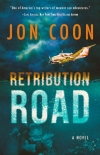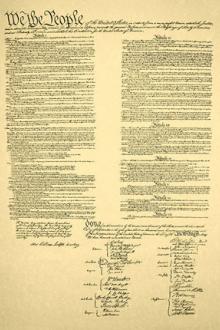Retribution Road, Jon Coon [top business books of all time .txt] 📗

- Author: Jon Coon
Book online «Retribution Road, Jon Coon [top business books of all time .txt] 📗». Author Jon Coon
Gabe held his ground, more from shock than courage, and watched as the reptilian head was transformed and became Alethea’s. Her face looked like white marble, her hair was wild and her eyes glowing. She looked down at Gabe and said, “Now you will believe.”
Gabe staggered to his feet and stumbled backward. He hit the floor hard and passed out.
When he woke he was back in the feather bed, and Cas was sitting beside him, stroking his chest and humming a tune he thought he recognized but couldn’t place. Sunlight filled the room, and Cas was at ease.
“Your mom?” he asked and rubbed his eyes.
“She’s doing better. She’s much stronger this morning, and the staff are amazed.”
“Have I been asleep the whole time? What happened last night? I had these really strange dreams. The house was full of people, and there was a ceremony, and—”
“Sure you were dreaming? I know you were really tired, but it felt pretty real to me.” She smiled and kissed him. “Coffee’s on, and then we can go see Mom.”
In a well-constructed bunker covered by jungle foliage, two sleek, fiberglass submarines, thirty meters long, sat in cradles on rails that ran three hundred meters into a deep lagoon. The subs were made in Colombia at a cost of two million dollars each, had diesel engines, and could run submerged at more than twelve knots. Several men sweated in the afternoon heat loading one of the subs with fifty-pound boxes of Semtex 10, a powerful plastic explosive that, like C-4, was made from a combination of RDX and PETN. Sandbags were loaded in the other to give stability and ballast. When two hundred forty cases of Semtex, equaling six tons, were loaded and secured, boxes of food and crates of bottled water filled the remaining cargo space.
Each sub would have a four-man crew. There were two bunks, a propane stove, and a bucket for a toilet. Fortunately it had a lid. The helm was a simple joystick, and instruments were limited to depth, surface radar, and a primitive sonar. Control for the water ballast system was by PVC plumbing and cabin pressure maintained with compressed air from a row of standard scuba tanks.
Bags of Baralyme for a single scrubber would keep the air breathable, and a single fan would provide the only cooling. Like many narco-subs of this size, each capable of carrying five to six tons of cocaine worth possibly 200 million dollars, these subs had been built for this mission and this mission only. One had a unique addition to the normal design: Four tires on retractable, battery-powered motors would enable it to crawl across the bottom—silent and nearly impossible to detect. It was an idea borrowed from the Navy’s NR-1, a 150-foot nuclear research vessel built in 1969 and used on covert ops for thirty years.
The crews were young, half not yet twenty, and the captains weren’t much older. Sebastian, captain of the explosives carrier, was twenty-two with thirteen prior missions, and Chris, short for Cristóbal, who would pilot the escape vehicle, was twenty with only two prior cruises. All were volunteers, and El Patrón had promised three times normal pay for successful completion. It was a generous offer and a grand opportunity for men used to making only $3,000 for a three-day run, delivering cargos worth hundreds of millions of dollars.
The two Zapa army trucks pulled away, their deadly cargo delivered. The subs were double-checked and the engines given last-minute care. The crews wished each other well and boarded. The hatches, that only closed from the inside, were secured. The cradles released and set down the rails until both boats were submerged with only the conning towers, barely large enough for one man, still dry.
Now the engines were started, exhausts checked for circulation, transmissions engaged and checked. A claxon sounded from each boat, and the cradles ran to the end of tracks, releasing them into the deep, clear water of the cove. They ran submerged at fifteen meters out into open water and the protection of their mother ship: a rusting container ship with Panamanian registry named Anna Christine.
The subs would cruise in the shadow of the ship. They knew that, even with the nearly undetectable fiberglass hulls, there was still a chance surveillance planes or Coast Guard vessel sonar could find them. The US had covered the Gulf bottom with acoustic monitors, but, hidden by the sound of the mother ship’s engines and the turbulence of its screws and its lumbering size, the chances of detection were close to zero.
Sebastian smiled as he eased his vessel to sixty feet and gave a thumbs-up to his men. “Easy money.” He laughed. “Easy money.”
Chapter 29
TOM WAS IN THE COMMAND center at the ranch talking with Senator Benson on a secure line.
“So far we’ve got nothing. The satellites haven’t seen anything, and there’s only normal traffic in the southern Gulf. How about you?”
Benson answered, “We’ve got the Boeing Poseidons from VP-16, NAS Jacksonville in the air 24/7. They can only stay about four hours, but we’ve got constant coverage. We brought over two of the Falcon 900 MPAs from San Diego and USS Gabrielle Giffords, she’s an Independence-class littoral combat ship—that means she’s a tri-hull that can run in very shallow water. But she’s also designed for anti-submarine warfare. She was in Mobile where she was built for some refit work, and we put her back at sea headed south. But still nothing. It’s like looking for a needle in a hayfield. That’s several times larger than a haystack.”
“What’s an MPA?”
“That’s Navy for ‘Maritime Patrol Aircraft.’ The Navy loves acronyms.”
“Got it. How about potential targets?”
“There are four nuke plants, including Crystal River, Florida, but it’s shut down. There are a dozen major oil refineries on the Texas, Louisiana, Mississippi coast, and two or three thousand offshore platforms, including about fifty really big ones in deep water. But unless Maria can get us more intel, we’re flying blind. Have you





Comments (0)